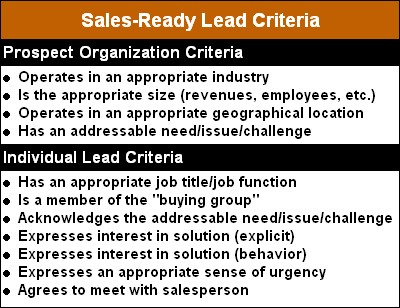A key requirement for a successful B2B demand generation system is a clear understanding of what a sales-ready lead is. Defining who a sales-ready lead is the first step in outlining the roles and aligning the efforts of marketing and sales. In an effective demand generation system, marketing is mainly responsible for bringing in new leads and nurturing them until they are ready for sales. When a lead is sales ready, the sales team takes on the main responsibility for managing that relationship.
The term sales-ready lead appears in many books, articles, and blog posts, but finding a truly useful definition is surprisingly hard. I’ll provide one shortly, but first, it’s crucial to understand what a sales-ready lead is not. A raw inquiry does not qualify as a sales-ready lead. A raw inquiry is someone who has shown only a slight interest in what you provide. They may have responded to an outbound lead generation effort or visited your website to fill out a registration form, but that’s all. The issues that arise when marketing sends raw inquiries to sales have been widely covered in demand generation discussions, so I won’t go into them here.
Sales ready is also not equivalent to ready to buy. Some people suggest that sales-ready leads are only those leads who are fully qualified using tradtional BANT criteria. In an earlier article, I discussed why BANT is no longer an effective framework for qualifying leads. The basic problem with BANT is that some of the criteria will not be met until near the end of the buying process, and in addition, it can be impossible for any individual lead to satisfy all of the BANT requirements.
A sales-ready lead, therefore, falls somewhere between a raw inquiry and a BANT-qualified lead. Here’s my proposed definition:
A sales-ready lead is an individual who (a) is affiliated with a qualified prospect, (b) can make or influence the decision to purchase your product or service, and (c) is sufficiently interested in exploring solutions to engage in a meaningful sales dialog with a sales rep. In this definition, the term qualified prospect means an organization that has a need your company can address and falls within your defined target market.
This definition provides a good starting point, but I also think it’s important to use some specific criteria for identifying sales-ready leads. The table below shows eleven criteria that I suggest are appropriate for most companies. The first four criteria apply to the prospect organization, and the remaining criteria apply to the individual lead.

OK, that’s how I define sales-ready lead. How about you? How would you change my definition? Would you use an entirely different approach?